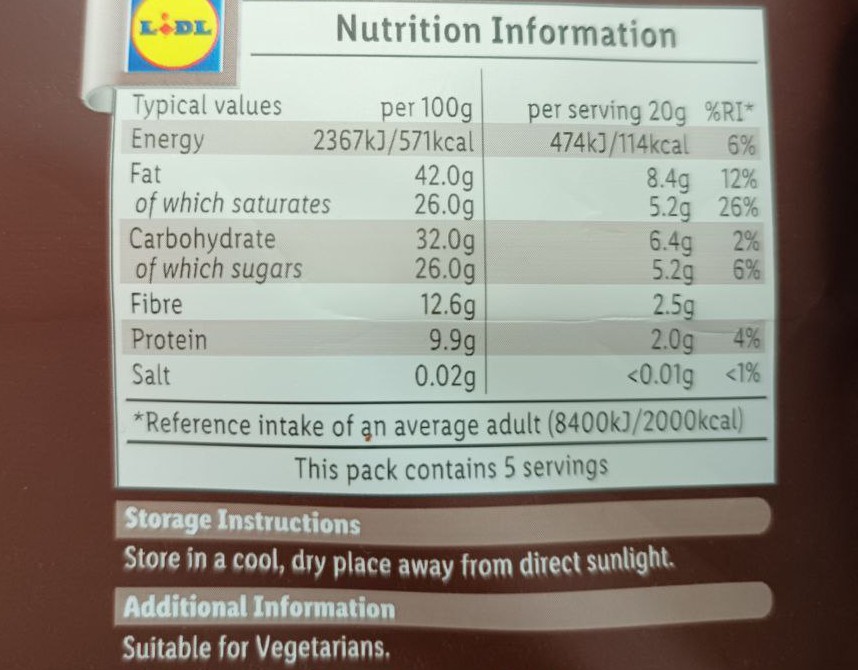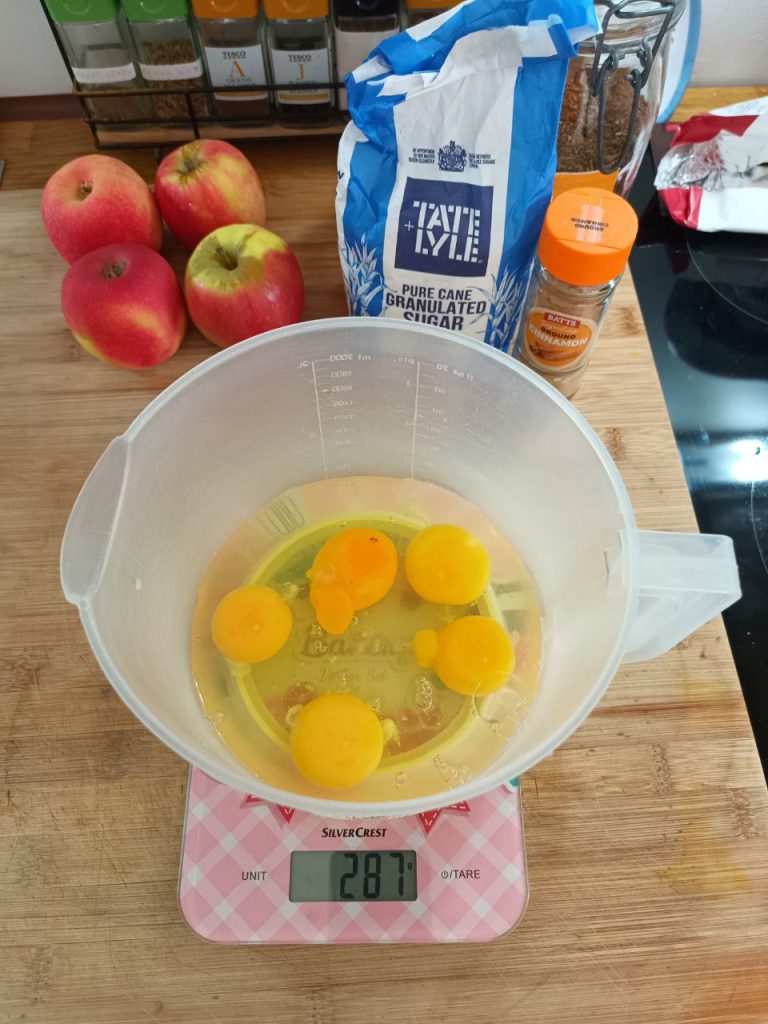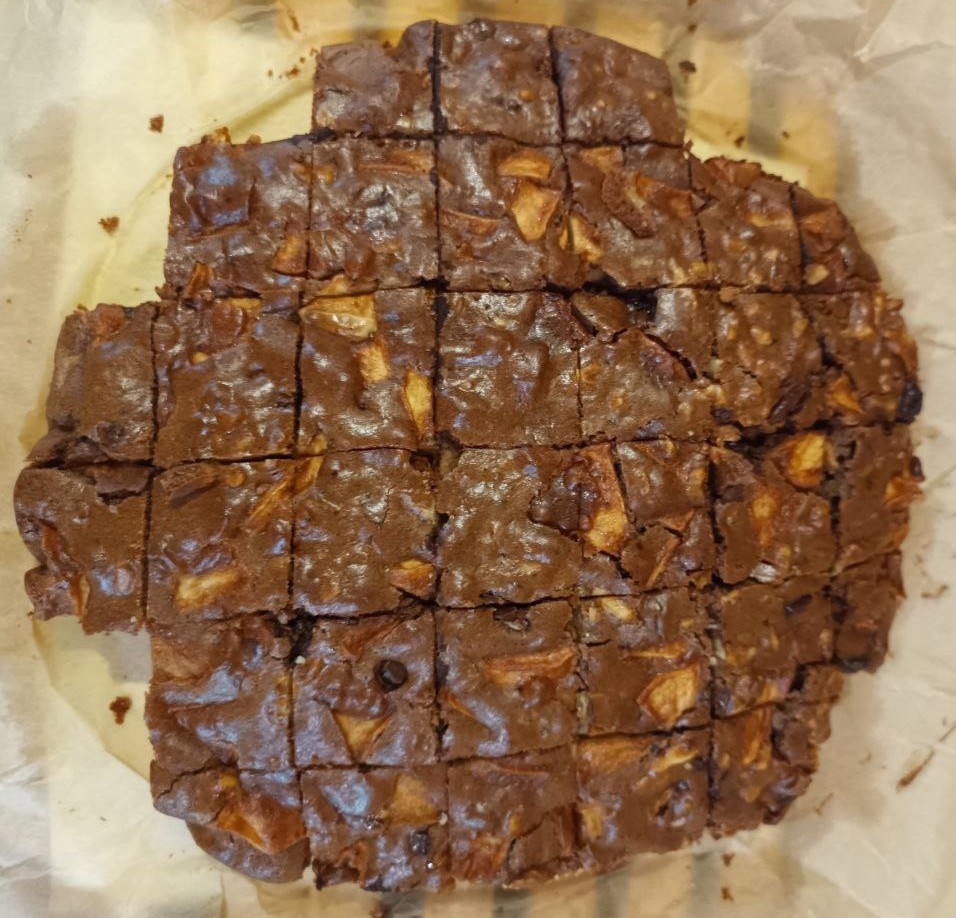This article is especially for those of you who prepare food, whether you run a small food business, a café, or simply love developing your own recipes.
If you’ve ever wondered how to calculate the nutritional values of your food, this is for you.
Some of you must provide a Nutrition Table by law; others simply want to add it as helpful information for your customers, and that’s perfectly fine too.
We’ll look at the method, the exact formulas, and then apply them to one of our own recipes — Julia’s Apple Walnut Brownie, also known as the Fivefold Brownie.
Do you need a laboratory to do this?
If you’ve always thought you need to send your food to a laboratory to know its nutritional values, you’re in for a nice surprise:
it’s not really necessary — you can calculate them yourself with excellent accuracy!
In this article, I’ll walk you through the whole process, step by step.
We’ll start with a simple example and then move on to a real recipe from our kitchen.
Who is required to display nutrition information
As a general rule, any business that prepares food that is pre-packed and sold to, or through, another business must display the following seven (or eight) nutritional values:
- Energy (in both kJ and kcal)
- Fat
- of which saturates
- Carbohydrate
- of which sugars
- Protein
- Salt
For example, if a café prepares panini and sells them freshly made in their own shop, there is no requirement to display nutritional values.
But if those same panini are wrapped and sold to another business (say, a local deli or petrol station), then the nutrition information must appear on the label.
Foods packed on the same premises where they’re sold (known as PPDS — Prepacked for Direct Sale) must show a full ingredients list with allergens in bold, but the nutrition table itself is not mandatory.
How are nutritional values calculated?
The principle is simple:
you add up the nutritional contribution of each ingredient according to how much of it you use, and then express the result per 100 g (or per 100 ml) of the final product.
This “per 100 g” basis is what allows people to compare products easily.
The basic formulas are:
For each ingredient:
(weight of ingredient × nutrient value per 100 g) ÷ 100
For the recipe as a whole:
(total nutrient in the recipe ÷ total recipe weight) × 100 That gives you the nutritional values per 100 g of your product.
Where to get the nutritional values of ingredients

There are several reliable ways to find the nutritional values you need:
- From your supplier’s label or specification sheet: this is the most accurate source for branded or packaged ingredients.
- From the food labels of any compound ingredients you use in your recipe; for example, dark chocolate, mayonnaise, or tomato sauce. These already include a full nutritional table that you can use directly (see picture example).
- From reputable food composition databases for basic single ingredients such as apples, eggs, flour, or milk. Here is an example of a high-quality database: https://quadram.ac.uk/UKfoodcomposition/login-register/
Whichever sources you use, stay consistent and keep them together with your recipe records: they form part of your traceable documentation if your products are ever checked or audited.
A quick example: Banana and Milk Smoothie
Let’s make a simple smoothie, one banana and 100 g of whole milk, and calculate only the energy value.
Per 100 g:
- Banana: 89 kcal
- Whole milk: 64 kcal
Now, if your banana weighs 90 g:
Banana → 90 × 89 ÷ 100 = 80 kcal
Milk → 100 × 64 ÷ 100 = 64 kcal
Total = 144 kcal
Total weight = 190 g
Per 100 g = (144 ÷ 190) × 100 = 76 kcal / 100 g
And that’s it! You’d repeat the same process for fat, carbohydrate, sugars, protein, and salt.
Be precise — treat it like a small lab test
It’s simple maths, but precision makes all the difference.

- Use a scale that weighs to at least 1 g.
- Note the tare weight (the empty bowl or tin), so you always know the true net weights.
- Stick to the same suppliers and ingredients each time, so your data stays valid.
- Keep your notes — they become your record of how the figures were obtained.
Practical Example: “The Fivefold Brownie”
Now let’s apply this method to a real recipe from home, one my wife Julia often makes.
We call it the Apple Walnut Brownie, or simply the Fivefold Brownie.
It’s called that because it starts with five of everything:
five medium apples, five tablespoons of sugar, five of flour, and five eggs.
Then we add 200 g walnuts, 200 g dark chocolate, half a cup of extra virgin olive oil (well, obviously!), a spoon of cocoa, a pinch of bicarbonate of soda, and a little cinnamon.
That’s our kitchen version.
Now let’s see how it translates into numbers.
Step 1: Weigh each ingredient
Before starting, note the tare of your bowls and tins so you can measure accurately.
Here are the measured weights from our test batch:
| Ingredient | Weight (g) |
| Eggs | 287 |
| Sugar | 102 |
| Flour | 162 |
| Cocoa | 20 |
| Cinnamon | 3 |
| Bicarbonate of soda | 2 |
| Walnuts | 200 |
| Extra virgin olive oil | 68 |
| Dark chocolate (A) | 84 |
| Dark chocolate (B) | 26 |
| Apples (prepared) | 399 |
Step 2: Calculate the nutritional contribution of each ingredient
Let’s take the eggs as an example.
Nutritional values per 100 g of egg:
Energy: 143 kcal (598 kJ)
Fat: 9.5 g (of which saturates 3.1 g)
Carbohydrate: 0.7 g (of which sugars 0.7 g)
Protein: 12.5 g
Salt: 0.36 g
Now apply the formula:
Energy: 287 × 143 ÷ 100 = 410 kcal
Fat: 287 × 9.5 ÷ 100 = 27.3 g
Saturates: 287 × 3.1 ÷ 100 = 8.9 g
Carbohydrate: 287 × 0.7 ÷ 100 = 2.0 g
Sugars: 287 × 0.7 ÷ 100 = 2.0 g
Protein: 287 × 12.5 ÷ 100 = 35.9 g
Salt: 287 × 0.36 ÷ 100 = 1.0 g That’s the contribution from the eggs.
You’d do the same for each ingredient.
Step 3: Add them all up
After all the ingredients are calculated and summed, we have the totals for the whole brownie:
- Energy: 4,290 kcal (17,801 kJ)
- Fat: 275 g (of which saturates 55 g)
- Carbohydrate: 360 g (of which sugars 205 g)
- Protein: 96 g
- Salt: 3 g
Step 4: Convert to “per 100 g”
Our finished baked brownie weighed 1,238 g.
To express the nutritional values per 100 g, we divide each total by 1,238 and multiply by 100.
Energy: 17,801 ÷ 1,238 × 100 = 1,438 kJ / 100 g
Calories: 4,290 ÷ 1,238 × 100 = 346 kcal / 100 g
Fat: 275 ÷ 1,238 × 100 = 22.2 g / 100 g
of which saturates: 55 ÷ 1,238 × 100 = 4.4 g / 100 g
Carbohydrate: 360 ÷ 1,238 × 100 = 29.1 g / 100 g
of which sugars: 205 ÷ 1,238 × 100 = 16.6 g / 100 g
Protein: 96 ÷ 1,238 × 100 = 7.7 g / 100 g
Salt: 2.6 ÷ 1,238 × 100 = 0.21 g / 100 g
Step 5: Calculate the nutrition per portion
When you cut the cake, you’ll always lose a bit: crumbs, broken edges, pieces that don’t look good enough to serve.
That’s your waste.
What remains is your usable or saleable product.
In this case, we ended up with 1,113 g of usable cake, which means a 90% yield, and we cut it into 34 equal pieces.

To calculate the nutritional values per piece, use this formula:
(total nutrient × yield) ÷ number of pieces
Energy: 4,290 × 0.9 ÷ 34 = 113 kcal per piece
Fat: 275 × 0.9 ÷ 34 = 7.3 g per piece
of which saturates: 55 × 0.9 ÷ 34 = 1.5 g per piece
Carbohydrate: 360 × 0.9 ÷ 34 = 9.5 g per piece
of which sugars: 205 × 0.9 ÷ 34 = 5.4 g per piece
Protein: 96 × 0.9 ÷ 34 = 2.5 g per piece
Salt: 3 × 0.9 ÷ 34 = 0.08 g per piece These figures give you a clear picture of what’s in each serving — precise enough to use on your label, menu, or for customer information.
Step 6: Labelling
Now that we know both the ingredient quantities and the nutritional values, we can create the label.
Ingredients must appear in descending order by weight at the time of mixing.
For compound ingredients (like dark chocolate), list what they contain in brackets.
And make sure allergens (like Wheat, Egg, Walnut, Soya) are in bold.


Example label:
Fivefold Brownie: Apples, Eggs, Walnuts, Wheat Flour (Wheat Flour, Calcium, Iron, Niacin, Folic Acid, Thiamin), Sugar, Dark Chocolate (Sugar, Cocoa Mass, Cocoa Butter, Fat-Reduced Cocoa Powder, Emulsifiers: Soya Lecithins, Polyglycerol Polyricinoleate; Flavouring. Dark Chocolate contains Cocoa Solids 50% minimum), Extra Virgin Olive Oil, Cocoa Powder (Cocoa Powder, Acidity Regulator: Potassium Carbonate), Cinnamon, Bicarbonate of Soda.
When the product name mentions an ingredient
If the name of your product highlights one or more ingredients; for example, if we decided to call our Fivefold Brownie an Apple Walnut Brownie instead, then the label must change slightly.
That’s because as soon as an ingredient is mentioned in the product name, you are required to show the percentage of that ingredient in the finished product.
This rule is called QUID, which stands for Quantitative Ingredient Declaration.
In our case, we used 400 g of apples and 200 g of walnuts in a cake that weighed 1,238 g after baking.
Apples: 400 ÷ 1,238 × 100 = 32%
Walnuts: 200 ÷ 1,238 × 100 = 16%
So the label would no longer simply read Fivefold Brownie.
It would now become:
Apple Walnut Brownie: Apples (32%), Eggs, Walnuts (16%), Wheat Flour (Wheat Flour, Calcium, Iron, Niacin, Folic Acid, Thiamin), Sugar, Dark Chocolate (Sugar, Cocoa Mass, Cocoa Butter, Fat-Reduced Cocoa Powder, Emulsifiers: Soya Lecithins, Polyglycerol Polyricinoleate; Flavouring. Dark Chocolate contains Cocoa Solids 50% minimum), Extra Virgin Olive Oil, Cocoa Powder (Cocoa Powder, Acidity Regulator: Potassium Carbonate), Cinnamon, Bicarbonate of Soda. This way, your label matches both the composition of the product and the name you’ve chosen — keeping everything compliant and transparent for your customers.
And there you have it
We’ve just gone through how to calculate nutritional values and prepare a compliant ingredient label — all without sending anything to a laboratory.
If you only need this for one or two products, it’s easy enough to do by hand.
If you’re working on several recipes, there are tools that can help, and of course, at Scientialex Ltd, we’re happy to assist you with nutritional calculations and food labelling for your products.
Some foods, like fried or dehydrated items, will need a bit of extra attention because of oil absorption or water loss, but the principle stays exactly the same.
Once you understand the method, it becomes simple. And if you know someone who would benefit from this practical guide, perhaps another food business owner, a baker, or a friend developing their own recipes, please feel free to share it with them.
You can simply send them the link to our Scientialex blog so they can read it too.